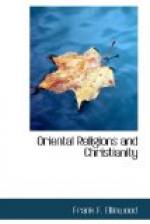It has been assumed throughout this lecture, that instead of an advance in the religions of men, there has everywhere been decline. Our proofs of this are not theoretic but historic. As an example, all writers are agreed, I believe, that during the historic period the religion of the Egyptians steadily deteriorated until Christianity and Mohammedanism superseded it. In strong contrast with the lofty and ennobling prayer which we have quoted from an ancient Egyptian record, is the degradation of the later worship. On a column at Heliopolis, belonging to the fourth century before Christ, is inscribed this petition: “O thou white cat, thy head is the head of the sun god, thy nose is the nose of Thoth, of the exceeding great love of Hemopolis.” The whole prayer is on this low level. Clement, of Alexandria, after describing the great beauty of an Egyptian temple, proceeds to say: “The innermost sanctuary is concealed by a curtain wrought in gold, which the priest draws aside, and there is seen a cat, or a crocodile, or a serpent, which wriggles on a purple cover."[159]
That the religions of India have degenerated is equally clear. The fact that all the medieval and modern reforms look back for their ideals to the earlier and purer Aryan faith, might of itself afford sufficient proof of this, but we have also abundant evidence which is direct. In the Rig Veda there is little polytheism, and no idolatry. There is no doctrine of caste, no base worship of Siva with the foul enormities of Saktism.[160] In the most ancient times there was no doctrine of transmigration, nor any notion that human life is an evil to be overcome by self-mortification. Woman was comparatively free from the oppressions which she suffered in the later periods. Infanticide had not then been sanctioned and enjoined by religious authority, and widow burning and the religious murders of the Thugs were unknown. And yet so deeply were these evils rooted at the beginning of the British rule in India, that the joint influence of Christian instruction and Governmental authority for a whole century has not been sufficient to overcome them.




